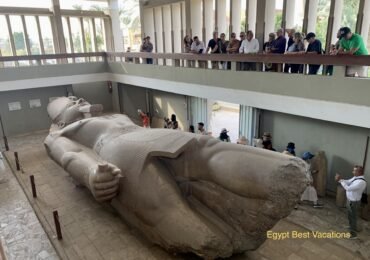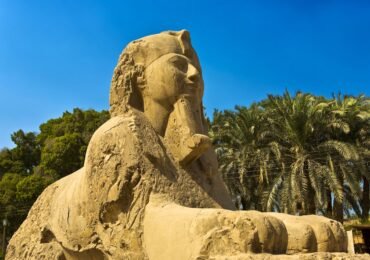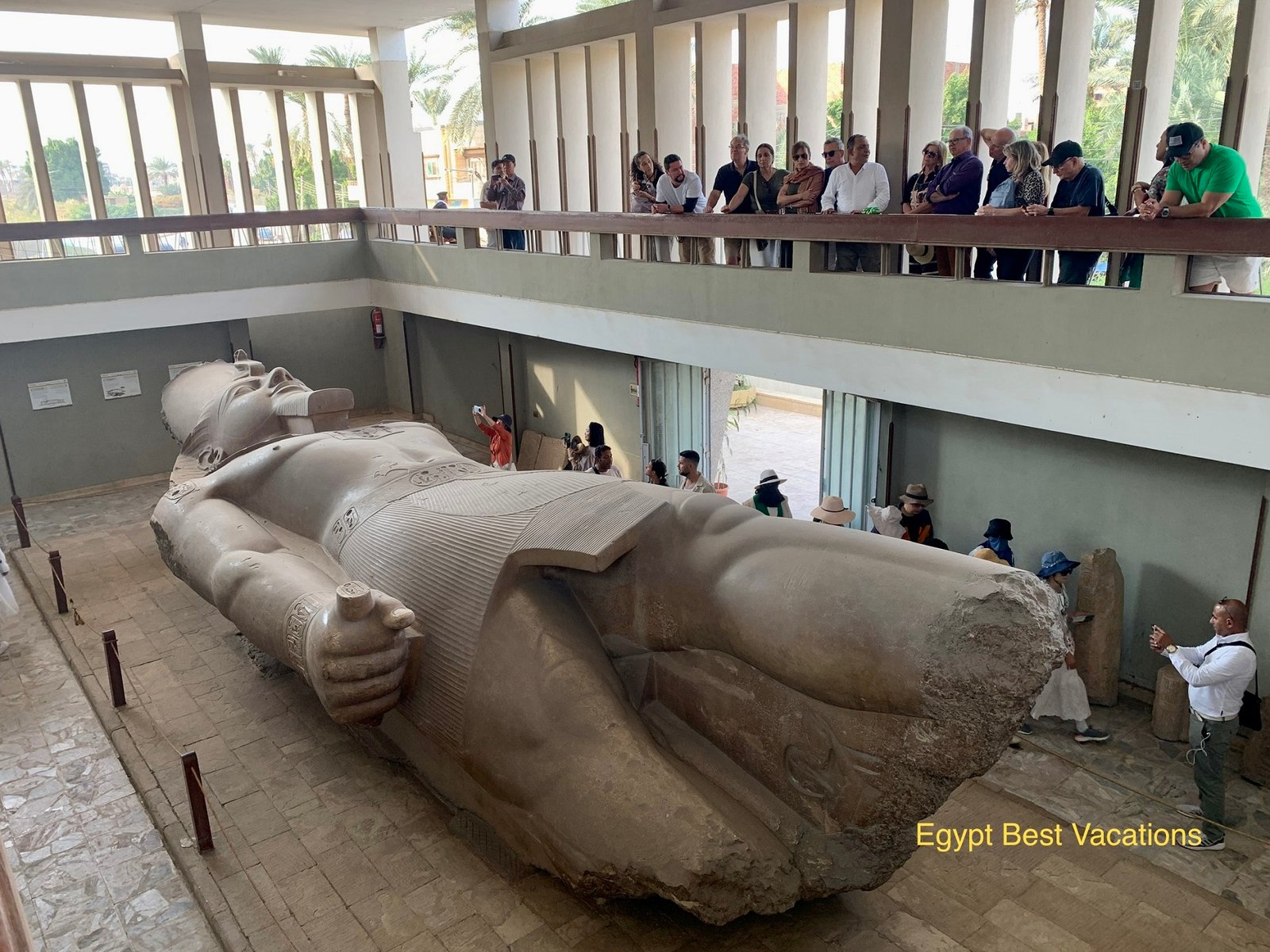The capital city of pharaonic Egypt, Memphis, lies under Mit Rahina. Over the last two centuries, a number of projects sought to learn more about Egypt’s ancient capital and to protect its archaeology. These projects made it clear that the archaeology of central Memphis now faced a critical situation. Mit Rahina is included in the World Heritage Site “Memphis and its Necropolis – the Pyramid Fields from Giza to Dahshur” which has been inscribed in 1979 under the criteria (I), (III), and (VI) (UNESCO, Memphis, and its Necropolis – the Pyramid Fields from Giza to Dahshur).
History of Memphis
Showing the sites would increase awareness of the need for conversation and maintenance. Increased tourism would generate opportunities for the local community. The museum is placed inside the ruin field of ancient Memphis. Located in the heart of the ruin field, the Memphis Open Air Museum at Mit Rahina consists mainly of a modern display area dedicated to a permanent collection of 81 stone artifacts of large size.
The site of Memphis, ancient Egypt’s only real capital city, has been cruelly neglected over the years. Founded at or around the beginning of the third millennium BC as the hub of the newly United Kingdom of Upper and Lower Egypt, Memphis maintained its importance through the various political turmoil of pharaonic history and beyond.
It comes as something of a shock to realize how little we know even now about the archaeology of the city itself. Of course, the city’s burial grounds are famous all over the world: the pyramids, elite tombs, and later, temple towns in the desert regions on both sides of the valley. Ironically it is when these funerary monuments are most obvious that the city itself has been until now almost invisible.
In recent times some attempts have been made to remedy this neglect, and resulting imbalance in our understanding of Memphis, with its undoubted central importance not only to pharaonic culture but to the social and economic life of the eastern Mediterranean.
Importance of Memphis
For the ancient Egyptians, Memphis represented a “primeval” place in many respects. As the earliest capital of a United Egypt, Memphis was the place where the pharaonic state had its roots. Memphis became, from a very early time, a special place where the Egyptian king could reassert their rule and rejuvenate their power, and where significant events, such as the royal jubilee festival (heb-sed), and later, the king’s coronation, took place. At the same time, the main local god of Memphis, Ptah, rapidly gained prominence until he became one of the principal state deities, closely tied to pharaonic royalty. Further, a local tradition is known as the “Memphite Theology” attributes the creation of the universe to Ptah, and suggests that the first piece of fertile land that emerged from the primeval waters was in the Memphis area, adding to the overall mythical impression of this great city.
Throughout Egyptian history, the temples of Memphis received particular attention from the kings, who built there extensively, erecting some of the most impressive pieces of pharaonic architecture and statuary. Thereby the sacred precinct of the god Ptah – the well-known (Hwt-Ka-Ptah) or (Temple of the Ka of Ptah), whose name will one day evolve into ancient Greek “Aigyptos” or “Egypt”, gradually become one of the largest temples in Egypt. Memphis always remained a metropolitan city throughout pharaonic history, housing the headquarters of various important institutions, notably the Royal Residence and the (kop), where the royal heirs were raised and educated.
Memphis Open Air Museum
Located in the heart of the ruin field, the Open Air Museum of Mit Rahina consists mainly of a modern display area dedicated to a permanent collection of 81 stone artifacts of large size. The display area – meant to emphasize three central places – is divided into roughly four parts, it consists of:
- A vast concrete shelter with a viewing platform for visitors to achieve a famous limestone colossus of Ramses II. This shelter also contains a range of smaller places distributed around the colossus, within the staircase, and along the front of the shelter.
- Outside the museum shelter, along its eastern side, three rows of concrete platforms form an open-air display area for additional places of varying sizes.
- Northeast of this, another centerpiece of the museum’s collection, a superb monumental sphinx of Egyptian alabaster of the 18th Dynasty, stands remote on a concrete plinth.
- East of the sphinx sits the museum’s garden, where another colossus of Ramses II, flanked by two lines of smaller artifacts, takes center stage. To the south of the garden, a vacant area contains an additional display platform intended for future use, the buried archaeological remains of a large enclosure wall, and extra space for the museum to expand.
History of Mit Rahina Museum
The history of the museum and its contents can’t be addressed without mentioning the long excavation history of the site of Memphis. The creation of the museum and the assembling of its collection of objects are both closely tied to the uncovering of the remains of this lost city. This starts with the museum’s building itself, a former version of which was built of mud-bricks, wood, and a tin roof to give shelter to the first significant discovery made in Memphis at the beginning of the 19th century, the colossal statue of Ramses II, which was known as Abu’l Hol.
However, one can imagine that the accumulation, year after year, the storerooms of the Department of Antiquities – as well as inside and around the Abu’l Hol shelter – of remarkable pieces coming from the excavations of Memphis gave rise to the idea of creating a museum where visitors could come and admire the area’s rich heritage. At that time, the shelter containing the Abu’l Hol colossus, already a must-see monument for tourists in Egypt, likely appeared as an ideal spot in which to develop such a museum. A decision was therefore taken by the Department of Antiquities, sometime in the early 1950s, to improve the existing premises.
Because of its proximity, priority was given to enhancing the display of the monumental alabaster sphinx found by Petrie’s team, which he had raised to higher grounds to protect it from water damage. As early as 1953, this gigantic sphinx was set up on a concrete base in the same location where people admire it today. Concomitantly, the construction of a museum building was also envisioned. The first project in 1955, initially consisted of a spacious building with a hall dedicated to the colossus centerpiece of the collection and two adjoined exhibition galleries for displaying other Memphite objects, as well as storerooms and spaces for visitors. For some reason was never completed.
Evolution of the Open-Air Museum at Mit Rahina
Eventually, this plan was altered and only a portion of the initial project was pursued. Following a series of soundings conducted to detect the presence of remains (the museum is placed inside the ruin field of the ancient Memphis), a brand new shelter – the one well known to visitors today – was built in concrete around the famous colossus and completed in 1959. No adjoining galleries were erected. Much larger than the former shelter, the new building was still spacious enough for displaying additional objects and for hosting the offices of the future director of the museum, staff, and police officers.
Some of the objects previously kept in the former shelter, were by then on display around the colossus and at the entrance of the building, while others were removed, perhaps to the storerooms of the Department of Antiquities. Larger pieces and the statues and pedestals that had long been gathered outside were simply kept around the new building until a solution could be found for their display.
The collection of the museum used to grow over the years as new discoveries were made and as objects from early excavations were rescued and moved to enrich the museum. The year 1986 was another turning point in the history of the Open Air Museum in Mit Rahania. Another colossal of Ramses II was restored in cooperation with the Memphis Brooks Museum of Art and the Institute of the Egyptian Art and Archaeology of Memphis State University.
Most important pieces of the museum
Let’s take a tour inside the museum and stop before the most important pieces there.
The colossal statue of Ramses II

As a consequence, this colossal statue was left for decades in its excavation trench, lying face down in the position in which it was found. Due to the clear artistic value of the colossus, several plans for re-erecting it were proposed but eventually abandoned. In 1887, a British weekly newspaper, The Graphic, published an illustrated article pointing to the alarming situation of this treasure face down, and regularly exposed to water damage.
Saving the Statue
Due to the emotion elicited by this article, a plan was adopted by British officials and entrusted by the Royal Engineers for rescuing the colossus. But owing to limited funds obtained through private donations, the initial plan for raising Abu’l Hol to an upright position was abandoned in favor of a more modest project. In 1887, the British Colonel Arthur H. Bagnold of the Royal Engineers was able to turn the statue over and raising it to higher ground, some 4.5 meters above its original location. After 5 months of work, the project was successfully completed.
During the same period of time, Bagnold also rescued two other major projects: the massive Stela of Apries, currently on display in the museum, and another beautiful colossus of Ramses II carved from red granite, famous for its relocation from Memphis to Cairo in 1952. In order to adorn Midan Ramses railway station, and again to Giza in 2007 for its planned installation in front of the new Grand Egyptian Museum.
Bagnold’s newly-built exhibition space for Ramses’s limestone colossus made the statue a major attraction for foreign travelers visiting Egypt, by allowing visitors to fully admire its outstanding artistic quality for the first time. After being rebuilt once in 1902 by the Department of Antiquities, the Abu’l Hol statue was then entirely replaced by the concrete building that still houses the colossus today, when the present Museum of Mit Rahina was created by the Department of the Antiquities in the late 1950s.
Its position on its back gives a great opportunity to inspect the carving up close – even the pharaoh’s nipples are very precise.
Standing colossal statue of Ramses II

The return of this beautiful piece to Memphis greatly enriched the collection of the museum and was the impetus for the creation of an additional display inside the Open Air compound. The following year, substantial enhancements were undertaken inside the museum compound. First, the twin counterpart of the colossus that toured the USA was also restored and raised again over a platform built near the open-air display area located on the east of the shelter.
Sphinx of the unknown king
A large sphinx was discovered in 1912, and it was carved out of the Egyptian alabaster. This is the second largest sphinx in Egypt, after the Sphinx of Giza. It is 8 meters long and weighs about 90 tons. From the facial features of the Sphinx, it may belongs to Queen Hatshepsut.
Other interesting pieces at Memphis Open Air Museum:
Seated granite statue of Ramses IV.
Group statue of Ramses II, Ptah, and Sekhmet.
Seated granite statue of Ramses II.
Standard-bearing statue of Ramses II.
Statue of a squatting baboon.
Statue of Bes and others.
It was until 2015, apart from the USAID, was given to renovate the museum’s building, the outdoor display areas, and some of the visitors’ facilities (benches, etc.). In addition, a children’s area was also created. Documentation for tour guides and visitors was produced.
How to get to Memphis Open Air Museum from Cairo?
Getting to the Memphis Open Air Museum from Cairo is relatively straightforward. Here are some options:
1. Taxi or Ride-Hailing Apps
- Duration: ~30-40 minutes (depending on traffic).
- Cost: ~300-600 EGP (depending on negotiation or app pricing).
- Apps like Uber or Careem offer a convenient way to book a ride directly to the museum. Simply input “Mit Rahina Museum” or “Memphis Open Air Museum” as your destination.
2. Private Tour
- Duration: Half-day to full-day tour.
- Egypt Best Vacations offers daily guided excursions to Memphis, often combined with visits to Saqqara and Dahshur.
- These tours include transportations, entrance fees and expert tour guides.
5. Public Transportation
- Option 1: Take a microbus from El-Mounib Station heading toward Badrasheen. Get off at Mit Rahina village.
- Option 2: Combine a metro ride to El-Mounib (Line 2) with a tuk-tuk or taxi for the last leg.
- Duration: ~1-1.5 hours.
- Cost: Microbus (~20 EGP), Tuk-tuk (~100-200 EGP).
Tips:
- Check the opening hours of the museum before departure (usually 8 AM – 5 PM).
- Wear comfortable shoes and bring water, as you’ll be walking outdoors.
- Combine Memphis with other nearby attractions like Saqqara and Dahshur for a fuller experience.

